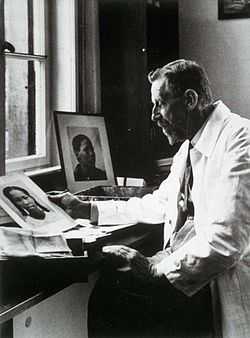Rhineland Bastard
Rhineland Bastard (German: Rheinlandbastard) was a derogatory term used in the Weimar Republic and Nazi Germany to describe Afro-German children of mixed German and African parentage, who were fathered by Africans serving as French colonial troops occupying the Rhineland after World War I. Under Nazism's racial theories, these children were considered inferior to Aryans and consigned to compulsory sterilization.

History
The term "Rhineland Bastard" can be traced back to 1919, just after World War I, when Entente troops, most of them French, occupied the Rhineland.[1] A relatively small number of German women married soldiers from the occupying forces, while others had children by them out of wedlock (hence the disparaging label "bastards"). The resulting children numbered from six to eight hundred.[2] The occupation itself had been regarded as a national disgrace by Germans across the political spectrum, and there was a widespread tendency to consider all forms of collaboration and fraternization with the occupiers as moral (if not legal) treason. The fact that it was carried out by what were viewed as "B-grade" troops (a notion that itself was drawn from colonial and racial stereotypes) increased the feelings of humiliation.[3]
In Mein Kampf, Hitler described children resulting from marriages to African occupation soldiers as a contamination of the white race "by Negro blood on the Rhine in the heart of Europe."[4] He thought that "Jews were responsible for bringing Negroes into the Rhineland, with the ultimate idea of bastardizing the white race which they hate and thus lowering its cultural and political level so that the Jew might dominate."[5] He also implied that this was a plot on the part of the French, since the population of France was being increasingly "negrified".[6]
Colonial legacy
However, most of the tiny non-white population in Germany at that time were children of German settlers and missionaries in the former German colonies in Africa and Melanesia, who had married local women or had had children with them out of wedlock. With the loss of the German colonial empire after World War I, some of these colonists returned to Germany with their "mixed-race" families.[7] While the black population of Germany at the time of the Third Reich was small at 20,000 - 25,000 in a population of over 65 million,[8] the Nazis decided to take action against those in the Rhineland. They despised black culture, which they considered inferior, and even sought to prohibit "traditionally black" musical genres like jazz as being "corrupt negro music". No official laws were enacted against the black population, or even against the children of mixed parentage, since they were the offspring of marriages and informal unions from before the Nuremberg laws of September 1935 which prohibited miscegenation. The law also deprived persons of mixed parentage their freedom to marry at all, or at least the spouse of their choice by banning future mixed marriages between Aryans and others. Instead, a group named "Commission Number 3" was created to resolve the problem of the "Rhineland Bastards" with the aim of preventing their further procreation in German society. Organized under Dr. Eugen Fischer of the Kaiser Wilhelm Institute of Anthropology, Human Heredity, and Eugenics, it was decided that the children would be sterilized under the 1933 Law for the Prevention of Hereditarily Diseased Offspring.[9]
The program began in 1937, when local officials were asked to report on all "Rhineland Bastards" under their jurisdiction.[9] All together, some 400 children of mixed parentage were arrested and sterilized.[9] This order applied only in the Rhineland. Other African-Germans were unaffected.[10] According to Susan Samples, the Nazis went to great lengths to conceal their sterilization and abortion program.[9]
See also
- Afro-Germans
- Degenerate music
- Hans Massaquoi
- Hans Hauck
- Kaiser Wilhelm Institute of Anthropology, Human Heredity, and Eugenics
- Nuremberg Laws
- Nazi eugenics
- Nazism and race
- Negermusik
References
- ↑ 'Black Germans' in Prem Poddar, Rajeev Patke and Lars Jensen, Historical Companion to Postcolonial Literatures--Continetal Europe and its Colonies, Edinburgh University Press, 2008.
- ↑ Tina Campt, Other Germans: Black Germans and the Politics of Race, Gender, and Memory in the Third Reich (University of Michigan Press, 2004), pp. 21,50 ff.
- ↑ Julia Roos, Women's Rights, Nationalist Anxiety, and the "Moral" Agenda in the Early Weimar Republic: Revisiting the "Black Horror" Campaign against France's African Occupation Troops. Central European History, 42 (September 2009), 473–508.
- ↑ Robert B. Downs, Books That Changed the World (Signet Classic, 2004), p. 325.
- ↑ Adolf Hitler, Mein Kampf (translated by James Murphy, February, 1939) Vol. I, Chapter XI (A Project Gutenberg of Australia eBook)
- ↑ Adolf Hitler, Mein Kampf, Vol. II, chapter XIII
- ↑ Evans, Richard J. (2005). The Third Reich in Power. Penguin. p. 527. ISBN 1594200742.
- ↑ "The fate of blacks in Nazi Germany". Deutsche Welle. 10.01.2010. Retrieved 9 November 2011.
- ↑ 9.0 9.1 9.2 9.3 S. Samples, "African Germans in the Third Reich", in The African German Experience, edited by Carol Aisha Blackshire-Belay (Praeger Publishers, 1996).
- ↑ Hans Massaquoi describes his experience as a half-African in Hamburg, unaware of the Rhineland sterilizations until long after the war. Massaquoi, Hans J., Destined to Witness: Growing Up Black in Nazi Germany, Harper Perennial, 2001. He mistakenly states (p. 2) that they were later murdered in the Holocaust.